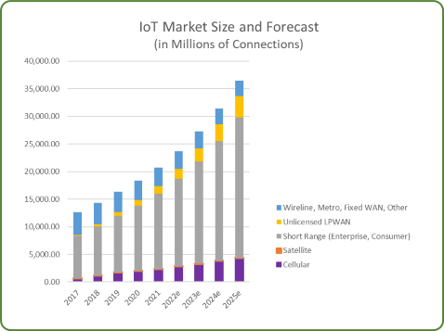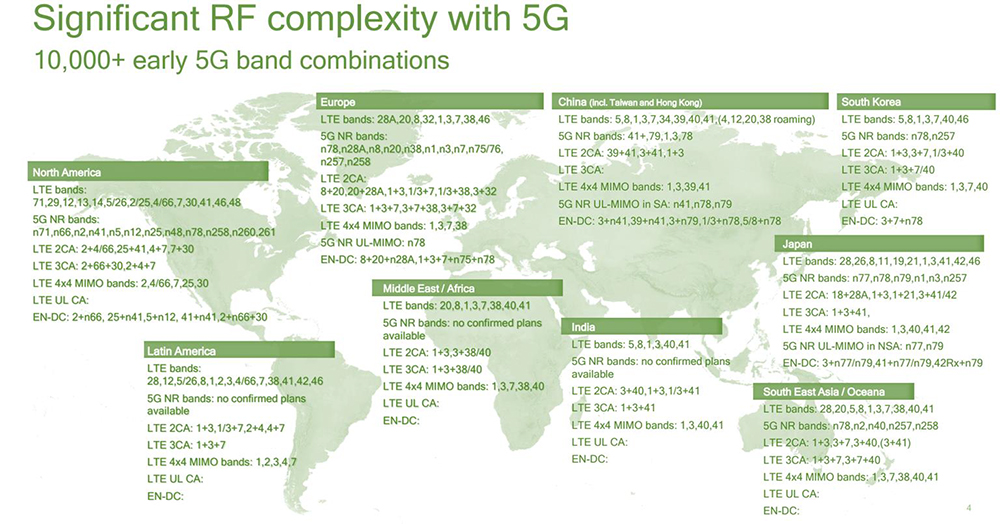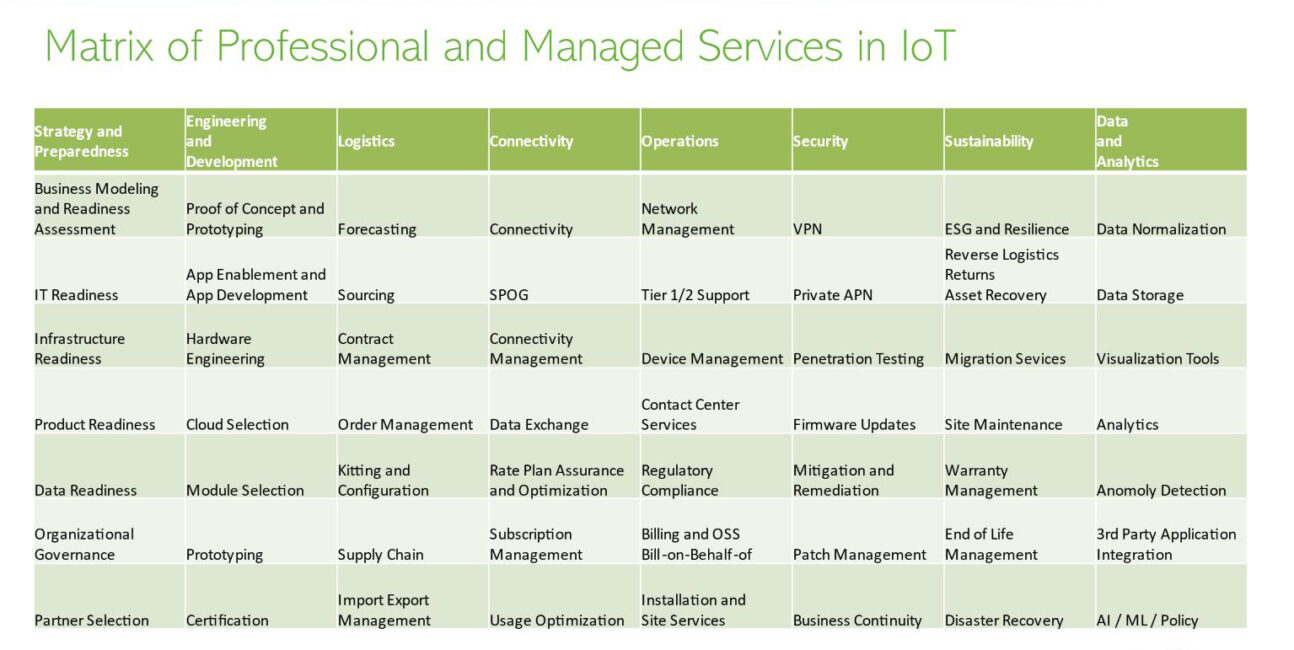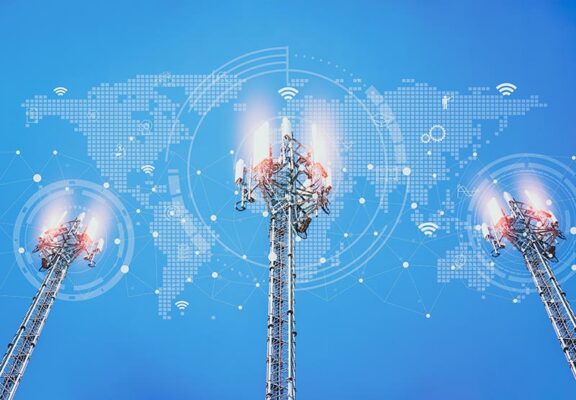
Introduction

Digitalization and the Internet of Things (IoT) are changing the way we interact with the world. More than 23 billion things are connected to the Internet. IoT is present in nearly every aspect of our work and personal lives. It dramatically enhances our interactions with the things we rely on daily. While IoT has experienced tremendous growth and acceptance over the past several years, IoT solutions often fail to meet expectations.
Table of Contents
There is ongoing market research to understand why this occurs, including multiple end-user surveys completed by James Brehm & Associates (JBA). We have learned that around 70% of enterprises have deployed IoT. However, most of these IoT solutions remain in a nascent stage of either testing or operation. Thirty-two percent of IoT projects are in limited-scale preproduction, proof of concept (PoC), prototyping or trial phases.
Meanwhile, 50% of enterprise decision-makers view IoT as transformational for their businesses. At a project level, 70% of IoT projects stall, are abandoned or fail.
Digging deep into the data, we learned that deploying an IoT solution can be complex. Our research shows that it takes an average of eight companies to develop and deploy an IoT solution. These companies may have multiple roles in the deployment and represent different layers or positions on the IoT stack.
For the past two years, a lack of IoT talent and relevant IoT skills have been IoT growth barriers, validating IoT’s complex nature. Almost half of respondents (i.e., 48%) cited a dearth of talent as their top challenge. With that in mind, it’s unsurprising that lack of experience is one of the main contributors to IoT project failures.
The JBA team has conducted an extensive analysis of the interviews and surveys. As a result, we have identified the critical steps for successful IoT solution implementation and deployment. Successful IoT solutions require experience in several disciplines. Failures often occur because companies don’t consider these disciplines when planning and implementing solutions. JBA’s research shows the problem is complex and, to succeed, IoT adopters often need help navigating it.
Telit Cinterion has been in IoT since before IoT was a term. As a leading provider, it has enabled many IoT triumphs but has also experienced its share of customer failures. That’s why the company set out to bring the pieces together through strategic acquisitions, talent management and operational excellence. Telit Cinterion has become a global, full-stack provider and leading Western brand behind some of IoT’s most successful and transformative deployments.
Why Is IoT So Complicated?
Let’s look at the basic elements required to build and deploy an IoT solution. Each of these elements must be present for the deployment to succeed. More importantly, each carries a set of considerations and requires unique expertise. We advise IoT adopters to consider these elements as they begin their IoT journey.

Figure 1: Basic anatomy of an IoT solution.
Hardware
In IoT, the thing is the device. Whatever your device is, you must choose how to connect it to the internet.
For brownfield deployments (i.e., connecting something already deployed and not ready to be replaced), you might add connectivity with an external modem or router. However,
embedding wireless technology directly into your device is ideal for new products.
The decision-making doesn’t stop there. Depending on the use case, you may choose from various wireless connectivity protocols, including:
- Wi-Fi
- Bluetooth® wireless technology
- Cellular
- Satellite
- Unlicensed LPWAN technologies (e.g., LoRaWAN)
About 84% of today’s connected things are connected wirelessly.

Figure 2: The IoT Market Size and Forecast graph shows number of connections and the connectivity types up to 2025.
Whichever wireless protocol you choose, you must meet and test against standards and regulatory requirements and attain certifications. Moreover, depending on where you intend to deploy, you may have to choose multiple frequencies for global coverage. Choosing global components that meet these criteria can determine whether your IoT application launch succeeds or fails.
Finally, many IoT applications are expected to operate in the field for years, often without intervention. Keeping up with the latest wireless protocols can be problematic if you don’t plan for long life cycles and minimize upgrade pains.
Telit Cinterion makes wireless module selection easy. Its IoT module portfolio includes cellular, short-range, LPWAN and combinations of technologies. For applications that require precise location data, Telit Cinterion makes positioning modules that connect to GNSS systems worldwide.
Its IoT modules leverage common footprints, and firmware over-the-air (FOTA) updates ensure
the modules are future-proof. Best of all, Telit Cinterion’s IoT modules are precertified to
streamline your deployment and comply with:
- Relevant standards
- Local regulations
- Operator requirements.
IoT Connectivity
Once hardware capabilities are embedded into your device, you’ll need a partner to provide and manage network service. The more countries you wish to deploy in, the more complex this decision can become.
Some countries require a local service provider and restrict roaming agreements. In addition, radio frequency (RF) bands used by carriers globally vary greatly. Therefore, a comprehensive understanding of connectivity issues is crucial to selecting the right network partners.

Figure 3: 5G band combinations worldwide. (Source: Qualcomm)
IoT device logistics include several steps before deployment. Carriers provide a connectivity management platform (CMP) to manage transitional states and classify SIM service levels.
Once you’ve chosen your communications service provider (CSP), you must understand how support, monitoring and management come together. Questions like the following must be addressed:
- How will devices be monitored, and who will monitor them?
- How will anomalies be handled, and who will handle them?
CMPs monitor device activity through the SIM and feature an application programming interface (API). The API allows IT to use the information in other support systems.
Each carrier has its own CMP. Multiple CMP solutions add to device management challenges when deploying a global solution. A few companies have developed a single pane of glass system that manages devices and connectivity across all carriers in the implementation.
Security concerns have risen with the number of IoT devices connecting to enterprise networks. Resources that ensure data integrity, reduce risk and enable updates are necessary to maintain trust.
Most IoT solutions have an active five-year life cycle. Patching software and firmware updates will likely be necessary during that time. Expertise in enabling secure over-the-air (OTA) updates is critical to operations.
Security solutions are often layers aimed at maintaining internal integration and defending against external threats. Deploying IoT devices diverges from most security plans and requires strategies to ensure integration and track anomalies specific to the IoT solution.
In addition to connectivity, another layer of cellular device management must be understood. Service providers may not allow a connection even though a device is compatible with the network. The device must use some form of SIM to access a service provider’s network.
NExT™, powered by Telit Cinterion, is an IoT MVNO core network with connectivity plans and SIM cards to address small to large IoT deployment challenges. It offers secure, managed connectivity to scale multisite deployments that span various mobile network operators (MNOs) worldwide.
NExT’s global SIMs give you access to more than 600 MNOs in over 200 countries with service optimization for coverage, quality and cost. Its intuitive dashboard provides complete visibility to your devices wherever they are.
Software
Once your IoT devices transmit data over a network, you’ll need software to make sense of the data. It will enable you to turn data into useful information and apply it to make better business decisions.
The class of software that translates sensor data into business intelligence is called an IoT platform. The market is rife with hundreds of organizations professing to have the ideal platform for your IoT application. However, few do everything needed to create a successful deployment.
Here are questions to ask when sourcing an IoT platform to support your application:
- Does it allow me to manage the communications link to my devices?
- Does it enable device management, including firmware updates?
- Can I create visualizations that make understanding the status and trends easy and actionable?
- Does it integrate with my company’s existing enterprise and operational software?
- Does it enable me to monitor and control my devices?
- Does it enable edge capabilities so I can keep my connectivity costs down and take urgent action if a device is disconnected from the network?
- Is it secure?
- Is it scalable
Once you’ve considered these questions, you may need more than one platform. Let’s look at common types of platforms on the market.
CMP
As discussed earlier, CMPs enable IoT connectivity management for devices across one or more networks. CMPs enable:
- Activation, provisioning or decommissioning of one or many devices
- Connection quality optimization
- Roaming management between or across networks
Telit Cinterion’s CMP provides all these functions.
IoT Platform
Many IoT solutions leverage an IoT platform. An IoT platform integrates and enables IoT solutions and connects devices, machines and applications. They were developed to solve technological hurdles outside an enterprise organization’s core competencies. These platforms provide edge intelligence and connect to secure cloud services to improve functionality and accelerate time to market for complex vertical enterprise IoT applications.
Device Management Platform
IoT solutions are often made up of disparate remote devices or machines. Because they may not be in close physical proximity, they’re difficult to update and service. RF hardware and communication software must be integrated to manage these remote devices. Integration enables software to track and show the device’s functionality details to manage and control it remotely.
These device management platforms (DMPs) often enable companies to understand the state of IoT devices better. For example, deviceWISE®, powered by Telit Cinterion, provides functionality for enterprises to manage devices and machines easily as they get deployed and redeployed.
IoT Security
IoT devices often use protocols and transmission formats not utilized by other enterprise operational or back-office systems. Moreover, enterprises are concerned about increasing the potential attack surface with additional entry points as they connect. With that in mind, security for IoT is quickly becoming one of the greatest enterprise challenges.
Edge vs. Cloud
IT has adopted the cloud as an economic and logistical advantage. With the cloud, it can outsource
IT management and reduce or eliminate the capital investment required to store and manage data
proliferation.
IoT leverages cloud services to:
- Remotely access, assess and manage geographically dispersed devices
- Aggregate disparate data formats
- Enable a comprehensive view of many assets
Nevertheless, engaging cloud service providers can come with added costs to store and process data. In some cases, it may result in unacceptable latency for mission-critical applications that depend on real-time data. Furthermore, relying entirely on the cloud for information and action can have disastrous consequences if the device loses its connection.
Many IoT applications leverage edge computing to mitigate these concerns. They integrate computing power and intelligence into the device or a nearby gateway capable of making simple decisions and issuing control commands.
Over the past few years, many IoT applications have leveraged a combination of edge and cloud computing. Telit Cinterion IoT platforms enable load balancing and can be customized to fit your application. In the interest of brevity, this discussion has just scratched the surface of what IoT platforms can do.
Integration
Enterprises often combine professional and managed services with platform-based solution development to supplement the powerful things platforms can accomplish. The table below addresses the many IoT platform services available and the need for professional services to bring IoT projects to life.
As a group, these professional services are considered integration services and touch each solution element. In fact, according to JBA’s research, integration services represent 75 cents of every dollar spent on IoT deployments.

Figure 4: The IoT managed service landscape.
At the edge, hardware development may require engineering and design services, including:
- PCB layout
- Antenna design
- Mechanical design
- Firmware development and customization
For network connectivity, IoT deployments need provisioning, installation, configuration and activation. IoT devices need application development, platform integration and settings both at the edge and in the cloud on the software side. Across all layers of the stack, IoT applications require testing and validation to ensure success.
Telit Cinterion has been an IoT enablement leader for over 20 years. The company works with customers to develop turnkey IoT solutions that seamlessly work with your business and technology stack. Telit Cinterion can help you avoid mistakes and overcome obstacles with integration services. It has the knowledge and experience to complete any project and ensure
your success.
Evolution of IoT Enablement
JBA has been analyzing IoT and consulting enterprises and members of the IoT ecosystem for over 100 years combined. We have seen countless companies fall victim to the misconceived notion that success equals doing it themselves.
Adopters of new IoT solutions can benefit from years of experience by leveraging the knowledge of organizations that have been there before. None can address the full stack like Telit Cinterion. After years of focus, investment and experience, the company has completed the marathon to turn your deployment into a sprint.
Telit Cinterion Timeline: Maturing into a Full-Stack IoT Enabler
| 1986 | Telit began as Telital, R&D services for multinational telcos |
| 1991 | World’s first SIM card |
| 1998 | Telit launched its first machine-to-machine (M2M) module |
| 1999 | The term “Internet of Things” is first used by Kevin Ashton of Proctor & Gamble in a presentation describing a system in which the internet is connected to the physical world via ubiquitous sensors |
| 2005 | Telit concluded its IPO on the London Stock Exchange |
| 2008 | Connected things outnumber people on Earth |
| 2011 | Telit acquired Motorola M2M (cellular modules) and GlobalConnect (managed services and connectivity) |
| 2012 | Telit acquired Navman (GNSS) |
| 2013 | Telit acquired ILS Technology (platform) and CrossBridge Solutions (connectivity services U.S.) |
| 2014 | Telit acquired ATOP module from NXP (automotive) |
| 2016 | Telit acquired Stollman (Bluetooth technology/NFC) and Novatel Wireless IP and products (MyFi, Wi-Fi) |
| 2017 | Telit acquired GainSpan (ultralow-power Wi-Fi) |
| 2021 | Telit delisted and became privately held |
| 2022 | Telit acquired Mobilogix (custom design and integration services); partnered with Thales to create Telit Cinterion, a leading western IoT solutions provider; opened a new global HQ in Irvine, CA, U.S. |
Key Takeaways
- You need hardware connectivity and software to build and deploy an IoT solution.
- IT adopted the cloud for economic and logistical benefits, but it may come with latency for mission-critical applications. IoT applications often leverage edge computing to mitigate concerns around the cloud. However, a combination of edge and cloud computing can be customized to your application’s needs and balance the load.
- To make your projects a reality, you need a partner that offers professional and managed IoT services across every layer of the stack to guarantee your success.


